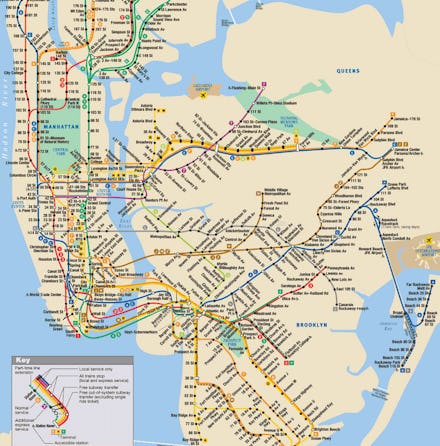NYC Subway Map Shows Every Line Going Up in Under 20 Seconds

This mesmerizing animation from very-appealing.com captures the New York City subway’s development, from the appearance of the oldest structures in the system in 1885, to the opening of the first underground line in 1904, through the system’s unification and refinement. It also showcases both the promise, and pitfalls, of free market development over time.
[Click to Enlarge]
[Click to Enlarge]
New York City’s subway is almost as old as the city itself, and the growth of the two is inextricably linked. The transit system has been featured in countless songs, films, and television shows, and its iconic signage, created by designers Bob Noorda and Massimo Vignelli, has been featured on everything from umbrellas to condoms.
While the system is now run by the Metropolitan Transit Authority (MTA), an independent governmental agency, its construction began under two private companies, the Interborough Rapid Transit Company (IRT) and the Brooklyn Rapid Transit Company (later the Brooklyn-Manhattan Transit Corporation, or BMT). The duo competed to construct the underground tunnels still in use today, and link them to elevated and street-level tracks in the outer boroughs.
Although the two private companies needed to collaborate with the city in order to build their tunnels, they were able to do so rapidly and decisively, especially as compared to the MTA and its governmental forebears. The piecemeal nature of the subway’s expansion is especially evident in the animation, as the IRT and BMT quickly cobbled together existing rights-of-way in the outer boroughs.
However, as the animation continues, the drawbacks of a lack of central planning become apparent. Lower Manhattan, where the first underground train began service, becomes almost overburdened with lines. Those same lines never reach entire swaths of the city, isolating thousands of people and worsening New York’s dismal traffic.
The city attempted to rectify these problems early on, creating its own company, the Independent Subway System (IND) and opening its first line in 1932. However, the Depression cut short plans for the second system that the IND hoped to develop, and in 1940, the IRT, BMT, and IND were unified under city control, leading to the centralized system New York has today.
The animation shows the efficiency with which private companies can operate, especially when today’s sluggish system growth is taken into account. However, it also shows that organic, free-market solutions aren’t always ideal ones, as short-term competition often outweighs long-term planning, or accounting for a municipality's needs.